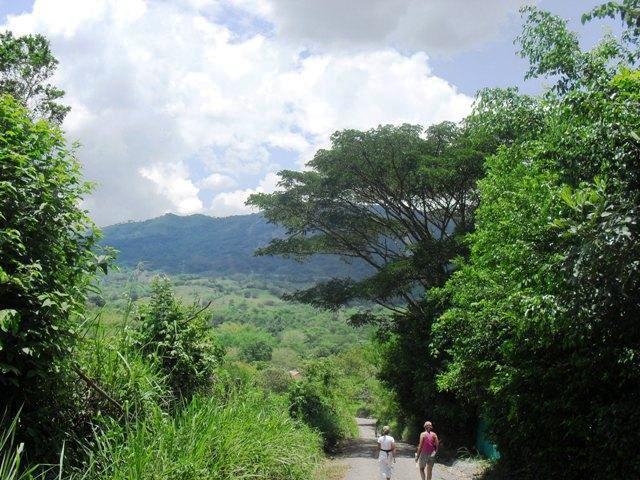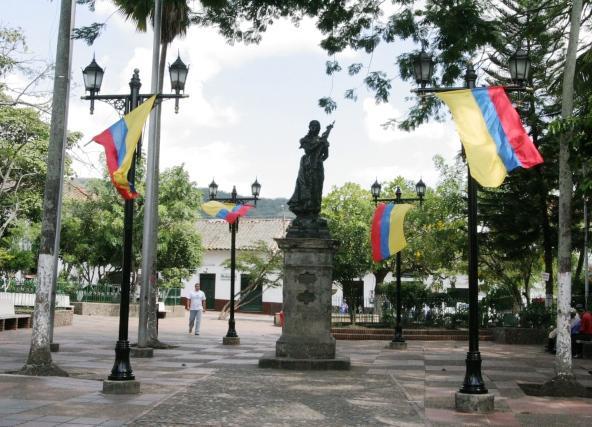Bajo Magdalena, Cundinamarca, Colombia
Suggest Place to Visit
538
Track to location with GPS |
 |
It was originally founded on April 20, 1572 by Andrés Díaz Venero de Leiva. It was abandoned after its foundation, until on December 13, 1610, Fray Tomás de Morales founded the Franciscan convent of La Soledad on the same site, around which the town grew again. On December 27, 1644 it once again obtained the character of a town when it was formally re-founded by Francisco Pérez de Guzmán.
In 1696, by a certificate from King Carlos II, it became a parish seat. In 1805 it passed to the secular clergy, and a little later the convent was closed. In 1809 the construction of a church in the town began, which was carried out under the direction of Fray Domingo de Petrés, a Capuchin architect who also directed the construction of the First Cathedral of Bogotá. The convent building, by order of the Congress of Cúcuta, was transformed into a prison.
Guaduas was a center of experimentation for the ´´Botanical expedition´´, which promoted, at the end of the 18th century, the introduction from the Antilles of the medlar, today widely cultivated in the region. In accordance with the provincial constitution of 1815 the canton of Guaduas was created, which in 1824 was incorporated into the province of Bogotá. Progress was rapid: in 1833 the first official schools were opened, in 1857 it acquired the category of departmental head, four years later the local hospital was founded, and in 1871 it was connected to the telegraph network.
Villa de Guaduas is a city in Colombia, in the province of Bajo Magdalena, department of Cundinamarca.
Geographic context
Geography
Physical description:
Location of the Colombian Municipality located to the northwest of the Department of Cundinamarca, with a distance to Santa Fe de Bogotá by road of 114 kilometers via Sasaima and 117 kilometers via La Vega. Its territory has an area of 757 square kilometers and is bordered on the north by Puerto Salgar, on the east by Caparrapi, Útica, Quebrada negra and Villeta, on the south by Vianí and Chaguaní and on the west by the Departments of Caldas and Tolima. Within its territory are the inspections of, Guaduero, La Paz and Puerto Bogotá. Its thermal floors are divided between warm and temperate.
The Villa de Guaduas is located in a beautiful valley, in a depression on the western slope of the eastern mountain range, a valley that is traversed in its entirety from east to west by a paved road called the royal road that was made by the indigenous and Mulattoes from the colonial era, led by the Spanish. This road was used during the trip from Santa Marta to Bogotá. It is a town of authentically Colonial semblance and Hispanic ancestry and because of its ancestry, the style of its architecture and the rich history that lies there.
Ecology
In the municipality of Guaduas there are areas of environmental importance represented in its water resources (rivers and lagoons), and innumerable hydrographic micro-basins, among which the San Francisco River stands out.
Economy
Basically it depends on Livestock, Agriculture, Oil exploitation, Fish farming, Poultry farming, coffee crops, sugar cane, banana, corn, cassava, cotton beans, cocoa, legumes, vegetables and fruits stand out.
In 85% of the villages of the municipality, livestock activity occurs, while coffee appears in 70% of them, followed by the sugar cane that makes its appearance in 65% of them.
Tourism: The 7 Wonders of Guaduas
The educational community of Guaduas chose in 2007, the 7 Wonders of Guaduas, a pedagogical project directed by the Departmental Educational Institution of Puerto Bogotá, under the direction of the Specialist in Ecological and Social Recreation, teacher Tiberio Murcia Godoy, who presented as a project degree of the Diploma CULTURAL HIGH MANAGEMENT OF CUNDINAMARCA, carried out by the Jhon F. Kennedy Foundation with the endorsement of the Department's Secretary of Culture, this project had the collaboration of the Specialist in Educational Management, Rector of the Luis Carlos Arboleda Rueda Institution, After analyzing the different proposals of the community, these were the Wonders chosen by the guadueros.
Convent of La Soledad
The Municipal Mayor's Office currently functions, it served to house Nariño and Bolívar among others, built by Father Fray Thomas Morales on December 13, 1610, this was the first colonial construction of the Villa, around which the town was gradually developed. population. Located next to the Camino Real.
Navarro Bridge
Located east of the Bogotá Port Inspection, Guaduas municipality. National monument on May 10, 1994, by Decree number 936 for technical and aesthetic merits and relevance in national history, as well as in engineering in Colombia. It was inaugurated on January 16, 1899.
Puerto Gallote
Located 3 km from the Inspection of Puerto Bogotá, the first river port of the new Kingdom of Granada, beautiful ruins with a 180º arch, colonial walls with stones carved in cooked brick and in normal brick were warehouses where merchandise was stored to later be transferred to Santa Fe de Bogotá, vestiges of this port are still preserved in good condition.
In 2008 this property was acquired by Mr. Hugo Mora, with the purpose of restoring this historical beauty and placing it at the disposal of world tourism.
Policarpa Salavarrieta House Museum
House where Policarpa Salavarrieta was born and lived located on the street called La Pola by order of the Municipal Council in 1917, is in the care of the municipal authorities
Aboriginal settlement
Located 22 km from the municipal seat on the road that leads to the municipality of Caparrapì, the base of its economy is agriculture. It has 520 inhabitants. As tourist attractions, the following stand out: The black river, the carrilera, the indigenous settlement, where archaeological pieces dating from approximately 200 BC are still being found. C., fossilized stones, hot springs (not yet exploited).
Museum of Arts and Traditions
The Patio del Moro was the first inn that existed in the town and one of the oldest houses, in total it has 100 doors, here a series of evenings, gatherings and conferences and a large number of cultural activities are held permanently. In the museum of arts and traditions, the elements of popular manifestations, customs and religiosity maintained in Colombia are collected, and especially in the Villa as well as the museum shop, where the historical products and typical of the industriousness of the region.
Piedra Capira viewpoint
The origin of this stone has never been studied in depth, whose viewpoint covers a large part of the region, revealing the Rio Grande de la Magdalena and the snow-capped mountains of Ruiz, Santa Isabel and Tolima.
Its access can be done by bridle path in a walk of approximately 1 hour or by car to a certain site and walk of 15 minutes. The first cross was placed on June 24, 1930, in the middle of the San Juan festivities, this celebration was carried out with a great banquet, in the Guaduera style (Lechona, Aguardiente, Chicha and Pólvora). In 1992 the first Mass was said.
In 1952, the Cundinamarca road system was connected to the western Colombian highways by means of a bridge over the Magdalena River, between Puerto Bogotá and Honda. That same year the Ezpeleta history museum was founded in Guaduas, which contains archaeological relics from the area and works of art from the colonial period.
On the stone there is a legend of the founders dating from the inauguration date, the legend is a recognition of the Moreno family (father and children).
Bogota port
It is one of the most important inspections of Guaduas, according to the historian Tiberio Murcia Godoy, ´´there is the most important river port of the New Kingdom of Granada, dating from the year 1555, and today it is planned to build a theme park there that collects much of the culture and history not only of Guaduas, or Cundinamarca but of the Republic of Colombia´´, in addition to the Navarro Bridge, which was built between 1894-1898, and inaugurated on January 16, 1899, for being the day of the birthday of its owner, Don Bernardo Navarro Bohórquez.
This Police Inspection is only two minutes from Honda, since it is only to cross the Luis Ignacio Andrade Bridge or also the Navarro Bridge. Thousands of visitors come here to taste the delicious capable widower, sweaty catfish and nicuro, fried mojarra.
It has an excellent Departmental Educational Institution of Puerto Bogotá. Here the Festival of the River and the Fisherman takes place.
Comments
We don´t have yet any comments about:
Guaduas
Guaduas
Be the first to leave a comment as it is very important to inform other people
Outros locais a visitar
Within a radius of 20 km from:Guaduas
Villeta |
| 15,4 Km |
 |
Hotel reservation near Guaduas within a radius of 20 km
Why to book with ROTAS TURISTICAS
The best prices
Our partnerships with the world´s largest operators offer research on the best market prices.
More options
At Rotas Turisticos you can book the hotel, buy the air ticket, book the transfer from the airport to the hotel and vice versa, book the local excursions, rent the car, take travel insurance and consult the places to visit and where to go.
Holiday Tips & Destinations
Hundreds of holiday destinations with all the options that allow you to easily choose the destination that best suits your dream vacation.
ROTAS TURISTICAS
Links






